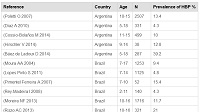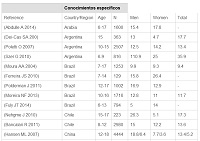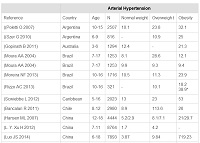Material and methods
Research Strategy
A systematic review was conducted according to methodology proposed in the Preferred Reporting Items for Systematic Reviews and Meta-Analyses (PRISMA) statement (Liberati A 2009) in which we included all of the cross-sectional studies around the world that reported and compared prevalence of hypertension among children and adolescents (5-18 years) according to their nutritional status, published in English or Spanish from January 2000 through December 2014. We included the following data base in our search: PubMed, MEDLINE, BioMed Central, Embase, Scielo, Redalycand Dialnet, this extended number of databases was used in order to minimize selection bias. We used the following medical subject headings and key words as outcomes: “prevalence”, “cross-sectional studies” or “Survey” and “children” or “pediatric” or “children” or “adolescents”, “young” and “blood pressure”, “high blood pressure”, “hypertension” not “pulmonary hypertension”. To get additional associated articles, we used the “related citations” function in PubMed and handsearched bibliographies of all the articles that met our inclusion criteria. This is a systematic review and no data were collected on humans, thus there was no need to be submitted to the Ethics Committee.
Selection of articles
From 8026 identified articles, 6044 were excluded based on availability in at least 7 databases, 1819 more on review title, abstract and range age made by 1 author. After this screening, 169 articles were reviewed in full by two members of the research team. Any differences were resolved through discussion, resulting in agreement for all of the included and excluded articles. In this phase 75 articles were excluded, 22 only reported general information about hypertension, 7 missed the age range, 19 were review articles, 25 were focused on the mechanism of the disease rather than its prevalence, and three reported results in another paper, where we included the first date result. Finally, only 94 studies met inclusion criteria for this systematic review (Figure 1).
 |
Figure 1. Screening and selection of studies included in this systematic review. |
Data extraction.
From the 98 included publications, two authors extracted independently the following information: Population characteristics, location, sample size, proportions of men and woman, method of blood pressure measurement and number of these, hypertension definition, global prevalence of hypertension, prevalence of hypertension among children and adolescents according to their gender and nutritional status. In the case of studies that missed the prevalence, the information was calculated and classified according to the age, gender or nutritional status when data allowed. The two authors compared extracted data and resolved any differences by discussion.
Results
Description of studies included in the systematic review
This article included 98 publications, which were classified according to the region where the research was conducted: 47 publications from Latin America, 8 from Europe, 6 from US, 33 from Asia, 3from Africa and 1 from Australia were obtained.
The research focused on the analysis of the prevalence of hypertension in three ways: Global prevalence in children and adolescents according to the region, gender, and nutritional status. For the study of the prevalence of hypertension in different pediatric and adolescent populations, we identified 57 observational studies, published from 2004 to 2014, describing prevalence in samples ranging from 52 to 25309 subjects from 30 countries; 36 publications were from Latin America, 3 from United Sates, 1 from Africa, 6 from Europe and 11 from Asia (Table 1). Considering the five regions listed, we observed that there is a higher prevalence of hypertension in Europe (17.1%) and USA (20.6%) comparing with the 4.87 % reported for Asia. However, Asia showed a higher prevalence in hypertension in adolescents (34.95%) compared to Europe (22.2%) or Latin America (16.93%). When populations, children and adolescents, are mixed in the same sample, the prevalence is higher in Latin America (16.93%) followed by USA with a percentage of 14.72%. Africa revealed the lowest prevalence of hypertension with 3.3%, though this interpretation must be carefully treated because few reports were found. Summing all studies, the total prevalence of hypertension was of 14.44%, with increasing frequency in the diastolic hypertension compared with systolic hypertension (17.14 and 12.92%, respectively).
 |
Table1.Prevalence of hypertension in different pediatric and adolescent populations. |
Comparison among countries
According to the regions, the highest prevalence of hypertension was observed in Latin America (23.41%), while in Europe there are similar rates in children and adolescents (22.2%), but when focused only in adolescents 34.95% of Asian samples are at the top.
Regarding to gender, both Latin America and Asia showed the highest prevalence in males, 17.92% and 17.28%, respectively, females 19.83% and 14.20% accordingly also; meanwhile Africa data presented the lowest, 3.9% in males and 5.3% in females.
In Europe the prevalence for both genders is the highest, 29.1% in males,16.1% females, at the same time in Asia are found the lowest (0.48 and 0.46% in males and females, respectively). Studies including children and adolescents accounted Latin America as the highest prevalence in males (23.09%) and females (2.83%).
Comparison by gender in children and adolescents
For the study of prevalence of hypertension among children and adolescents according to gender, 60 observational studies were identified: 23 from Latin America, 8 from Europe, 12 from United States, 25 from Asia and 3 from Africa. Observational studies were mainly from China (7) and India (14), in Latin America 13 were focused on adolescents; meanwhile, America and Africa only reported studies in children (Table 2). From these 60 studies, the total prevalence of hypertension in males was 15.65% and 14.6% in females, where the tendency was higher in males, especially in Latin America, Asia, and Europe; America and Africa showed a slightly higher prevalence among females over males (15.88% vs. 14.3% from US and 5.2% vs. 3.9% from Africa).
Only four studies reported prevalence systolic and diastolic specifics; the total diastolic prevalence in male was 8.87% in female 9.29%, in regards to systolic hypertension 10.09% in male and 9.03% in female. In both genders there is higher prevalence of diastolic hypertension.
A comparison between males and females, showed a higher prevalence of hypertension in males from Latin American, Asia, and Europe.
This may be because US and Africa had only one article, so it meant that there was not a real comparison of the populations of these regions. In the case of Europe, when the studies were conducted in both populations, the prevalence is higher in girls (6.4%) than in boys (4.7%). With these comparisons, it can be surely said that there is a higher prevalence of hypertension in males (14.67 %) than in females (11.59 %) across the world.
 |
Table 2. Prevalence of hypertension in children and adolescents according to gender. |
Comparison according to nutritional status
30 publications reported the prevalence of hypertension in children and adolescents according to nutritional status, where 14 were from Latin America, 5 from Europe, 2 from United States, 7 from Asia, 1 from Africa and 1 from Australia. (Table 3).
When considering only children population from the different regions, hypertension is present in 12.32% of normal weight children, 18% from overweight and 19.32% among children with obesity. Latin American and Caribbean countries count the highest prevalence of hypertension in all nutritional status; 27.62% of those with normal weight, 28.2% overweight and 24.92% obese, a prominent issue in Guatemala and Caribbean countries.
On the other hand, the lowest is in Asia (3.87% normal weight, 8.84% overweight, 19.23% with obesity); in Europe, reports are comparable to those in Latin America, likewise Spain and Lithuania are the biggest contributors to the figures. In the United States, the prevalence is substantially higher across all nutritional status ranging between 18 and 29%, children with obesity did signal the highest prevalence, although those in normal weight showed a high rate of hypertension (20.8%) compared to other regions.
Among adolescent population, Europe reported the greater prevalence of hypertension regardless of nutritional status, 18.9% with normal weight, 40% overweight, and 49.4% with obesity; the lowest prevalence is reported in Latin America in the case of normal weight (4.5%) and overweight (8.07%), meanwhile Asia showed just 3.2% in obese population.
Prevalence among children and adolescents showed lack of differentiation regarding obesity, however statistics in normal and overweight samples indicate higher frequencies in adolescents (normal, 12.32%, overweight 18%, and 24.94% with obesity). Among the six regions, the United States denotes the highest prevalence with normal weight 20.8%, in contrast to Australia with only 1.24%, overweight in the US 33.5%, and Africa 5.3%; similarly, with obese Latin America 34.54% and the United States just 8.95%. Teenagers in Europe denoted the higher prevalence across all the Nutritional Status, Latin America the lowest with normal weight 4.5% and overweight 8.07%, Asia 3.2% of those with obesity
 |
Table 3. Prevalence of hypertension in children and adolescents according to nutritional status. |
Discussion
It is generally believed that the age is a factor that contributes to the increase in blood pressure (Demirci H 2013) (Moreira NF 2013), this report illustrates the high prevalence of hypertension in both children and adolescents, watching a clear trend related to the age, according to our data, adolescents’ reports higher prevalence rates than children. A possible explanation could be the evidence showing the presence of cardiovascular risk factors during childhood that follows through adulthood (Suárez Cobas L 2009) (Poletti O 2007) (Sukhonthachit P 2014); in this regards, it is suggested that blood pressure increases with age, in both males and females (Alpert BS 1994), and that boys are more likely to suffer hypertension. This could be explained based on some studies that indicate higher rates of abdominal obesity among males than in females (Sánchez de Castro 2009) (Poletti O 2007) (Lauer RM 1989). On the other hand, it has been suggested that the influence of gender on hypertension is highly correlated to the body growth (Leccia G 1999), which is steeper during the adolescence period rather than preadolescence among males (Bachmann H 1987) , yet the mechanisms responsible for the gender differences in blood pressure are not quite clear enough. Some reports indicate that during adolescence and puberty, when androgen levels are increasing, blood pressure is higher in boys compared to girls (Jane F 2001) (Al-Sendi AM 2003).
In addition, our results suggest that diastolic hypertension is more common, in both boys and girls probably due to factors that may occur in early life associated to increased oxidative stress, hyperinsulinemia (Agirbasil M 2014) and dysplidemia (Bachmann H 1987) which promote periferical vascular resistance that determine diastolic hypertension (Pinto 2007).
Despite nutritional status, the information is not yet well disseminated and the lack of early diagnosis worsens the situation. Early identification of overweight is recommended to refer children to appropriate advice and treatment to prevent comorbidities. Our data showed that the prevalence of hypertension in obese children is high in several countries from Latin America. The proportion of population whose health is at risk related to inactive lifestyles is close to 60% (Báez de Ladoux D 2014). Come other factors that make children and adolescents prone to suffer from hypertension are: family history, few resources in the field of public health, as well as lack of public information on these conditions, but mainly unbalanced diets and lack of physical activity (Báez de Ladoux D 2014) (Barberán Solórzano K 2011) (Hakim A 2014) (Aregullin-Eligio. 2009).
Also, we observed that the nutritional status strongly influences whether people are more likely to suffer hypertension, since it was shown that overweight and obese young people undergo more this condition, as other reports has proposed (Suárez Cobas L 2009) (CossioBolaños M 2014) (Aguirre CJ 2012). The increase in obesity and overweight rates and their comorbidities there has been more interest on the topic of blood pressure assessment in children and adolescents in recent years. Overweight in children and adolescents have increased significantly across all age groups and both genders; accompanied by greater BMI values. Also, among all age groups and genders, accompanied by increased BMI values, in recent decades there has been a progressive rise in essential hypertension associated in part to the number of cases of obesity and overweight in children and adolescents. One study showed that being overweight or obese increased seven times the chances of hypertension, after the adjustment for gender and age, confirming that obesity is strongly linked to high blood pressure in children (Aguirre CJ 2012) (Barberán Solórzano K 2011).
Similarly, because the alarming data on the prevalence of childhood overweight and its metabolic consequences have been rising (Fallah Z 2014), we could expect a growth in the prevalence of hypertension, since there is a strong association between these nutritional status and hypertension (Diaz A 2010) (Guido. 1989) (Barberán Solórzano K 2011) (Corado Escobar 2007) (Perichart PO 2007) (Aregullin-Eligio. 2009). Our data showed that the prevalence of hypertension among children with obesity is higher in Latin America, but for normal and overweight groups, it is higher in the United States meanwhile Europe has higher prevalence for teenagers.
Furthermore, prevalence of hypertension was higher among studies from low and middle income countries, specifically in Latin America and Caribbean countries, socio-economic and cultural factors should be considered as strong influence to the prevalence of metabolic diseases as not only obesity has been suggested (Chiolero A 2007). Shortages are well known in certain developing areas, which at the end are reflected in the prevalence of hypertension (G.-R. F.-G.-P.-M. Rodríguez-Morán M 2013). However there is recognition of alarming data worldwide that is reported in papers from emerging and industrialized countries (Fallah Z 2014) (Aguirre CJ 2012) (Cinteza E 2013) (Sukhonthachit P 2014).
According to studies of hypertension in the United States, it is shown that the Hispanic population suffers more this condition, followed by Asian, then by African Americans and lastly Caucasians. Other hypertension studies that have evaluated socioeconomic status and stress in African American and Caucasian children, have found higher rates of hypertension among African Americans. These studies concluded that exposure to chronic environmental stress and low socioeconomic status contributes to hypertension (Ferreira de Moraes AG 2014) among African American youth (Urrutia-Rojas X 2006). Results show that factors associated with hypertension (e.g, obesity and ethnicity), may play a role in the development of hypertension at early age, and can be used as an independent marker for increased likelihood of hypertension among children (Urrutia-Rojas X 2006), (Koebnick C 2013) (Ferreira de Moraes AG 2014) (Sorof JM 2004).
Our systematic review revealed that Africa and Australia countries count the lowest prevalence; this could be a result of limited data on the prevalence of hypertension in these regions, where only four studies met criteria, probably leading to underdiagnoses (Ellenga Mbolla BF 2014) (Okoh BA 2012) (Ujunwa FA 2013) (Badi MA 2012). Likewise, we recognized that there is an implicit bias of selection of the articles but we considered the number of documents that were reviewed compensated this disadvantage.
Even the diagnosis method for hypertension were reviewed, not all studies described them properly, thus the prevalence of pediatric hypertension can also be influenced by the methods of measurement, type of devices used to measure, their validation and calibration as well as auscultation process (Diaz A 2010) (Tandon N 2013) (Dulskiene V 2014). In this sense, the method of measurement seems to have an important role in the overall heterogeneity of HBP value as suggested for Ferreira de Morares et al. and standardization is required to guarantee a proper methods and techniques remains (Ferreira de Moraes AG 2014).
The main strength of this study is the conduction of a thorough and systematic research from multiple databases; therefore, it is likely that all of the relevant published studies were identified. In addition to the fact that two authors, independently, reviewed articles for inclusion and exclusion, extracting data, which improves the validity of the results. We also identified studies from multiple countries, improving the generalizability of the findings.
Perspectives
These findings suggest that, despite the wide range of reported prevalence, hypertension is a major public health problem in pediatric populations and seem to be higher in low and middle income countries. Our results strain the importance of early detection of this disease, and the need to make a screening of hypertension during childhood and adolescence, likewise, to deep study the epidemiology of high blood pressure in order to identify risk population that leads to a better and proper treatment.